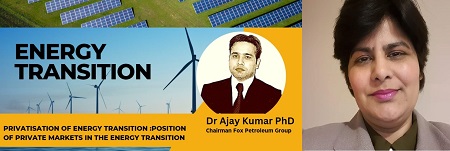
Interview-by-Dr-Manu-Chaudhary-of-Dr-Ajay-Kumar-PhD-Chairman-fox-petroleum-Group
Interview by Dr Manu Chaudhary on : The Privatisation of Energy Transition: The Position of Private Markets in the Energy Transition. With Dr Ajay Kumar PhD Chairman fox petroleum Group.
Qns. Mr Kumar : What is this energy transition and its due need? We have not transited yet – from Hydro to coal to LNG?
Ans. Yes we have transited many folds. That is not enough to save the earth. The past ten years was hotter than any other period in the previous 125,000 years, attributable to rising greenhouse gas (GHG) emissions — principally carbon dioxide, methane and nitrous oxide — primarily released from the combustion of coal, oil and gas but nuclear waste is not counted here. Hence an energy transition is in demand, and private players has been invited to give a shape to the thought. Hence, privatisation came into the mind of policymakers.
Qns. Mr Kumar – are you saying without the privatization this so called energy transition is meaning less. What I mean is – Government alone is not capable of making it happen for a bigger cause – save the earth, reduce carbon emission etc etc?
Ans. I didn’t say that. But taking private people into this discourse is very good. Its not new coming of private players into Government Business. Yes, so far I can say, Privatization represents a reversal of the process of nationalization activated early in this century. In most Communist nations, a wave of nationalizations ensued shortly after Communist governments assumed power in the aftermaths of World War I (WWI) and World War II (WWII). In Western Europe, the nationalization process stretched over several decades but essentially took hold in the 1930's.
Energy transition refers to the global energy sector's shift from fossil-based systems of energy production and consumption — including oil, natural gas and coal — to renewable energy sources like wind and solar, as well as lithium-ion batteries. The energy transition is entering a new and accelerated phase at a time of rapid change in the financial sector. In Indian scenario – Electricity generation was open to the private sector after EA2003. The private sector now accounts for 39 percent of power generation capacity compared to 21 percent for the central sector and 24 percent for the state sector.
Qns. Mr Kumar, then can you follow up with your knowledge the impacts it is going to give on world economy and in todays scenario the job. The job is bigger then making earth green in these days.
Ans. Private markets leading the Energy Transition is a new normal, but not started today. It has a background. Privatization has also been driven by the increasing globalization of the world economy, it helps grow the economy and creates job without cutting other infra related job created by other sources of energy. Several decades of rapid growth in international trade and investment have made competitiveness in international trade an essential factor in a nation's ability to create jobs, raise real wages, and generate wealth – “it was the aim”.
For many nations, privatization has become the only effective method of raising investment capital on favourable terms. High levels of past public sector borrowing have saddled many nations with large levels of debt. As a consequence, these nations have had little recourse but to sell state assets to reduce debt, generate revenue, and raise investment capital. India is doing faster in this Government. India sold many things to cut down the debts.
For Example for your understanding, countries as different as the United Kingdom and Chile have led the way in privatization. Countries as different as Peru and Poland have followed. Between 1988 and 1993, roughly 2,700 state-owned enterprises in over 95 countries were transferred to private individuals, raising over $270 billion {see Endnote 4}. In Western Europe, the United Kingdom was at the forefront of privatization. Britain has raised $95 billion through the privatization of formerly state-owned enterprises.
Various businesses have been privatized besides oil. Indeed, the largest privatization to date has been the sale of Japanese Telecom for $73 billion {see Endnote 6}. In the United Kingdom, public housing has been privatized and, in the United States, many municipal services, such as waste disposal, have been privatized.
Qns. What difficulties corporate is facing, and are they getting good government support for energy transition, and finally, money is needed – how is capital market reacting on energy transition, are they happy investing in new field?
Ans. I am optimistic. Investment in the energy sector specially in energy transition – is not in a rhythm. It has some confusion, still we can not define the confusion as policymakers has confused it boringly. Even we hear we need electricity, but turbine manufacturing down, not seeing new announcement in energy sector, is forcing capital market also to think – what’s happening ? BNEF tracks investment in the global energy transition, covering everything from renewables and nuclear to electrified transport and heat, hydrogen, carbon capture and sustainable materials. Global Low- Carbon Energy Technology Investment Surges Past $1 Trillion for the First Time. It is increasing at over 8% annually over the past 10 years. Yet, despite enormous advances in the cost-competitiveness of renewables over the past decade, investments in clean energy are still falling short of the level needed to put the world’s energy system on a sustainable path.
The climate-tech corporate finance totaled $119 billion in 2022. This category of investment, not included in the $1.1 trillion above, describes new equity financing raised by companies in the climate-tech space, either from public markets or private investors. The figure represents a 29% decline from the year before, driven entirely by a fall in public share offerings during a challenging year in global equity markets. Despite the turmoil, venture capital and private equity financings held up well, growing 3% on the year. Supply chain and manufacturing investment rises to $79 billion, dominated by China.
Even politicians in the name of Green Energy a narrative has been put forwarded by about the benefits of investing in solar PV, wind, and other clean power technologies. This story goes that renewable generation assets, when backed by remuneration based on long-term contracts and policies, offer: but Financial performance that is less correlated with the economic cycle still has an edge with predictable and stable free cash flows that attracts, and that cash yields over long durations gives investor a creativity to invest. In other words, this ideal-type of renewable power investment offers improved diversification, better liability matching, and less volatility. Yet this idealized hypothesis about renewables has not received universal support from quantitative assessments.
Because – the cost of capital provides a critical benchmark to assess the risk and return preferences of investors and the pricing of money in the wider economy, and can act as a lever for financial flows to influence prices and choices in the real energy economy. But decision makers lack access to reliable financing metrics across sectors and geographies, especially in emerging and developing economies. Inadequate assumptions around the cost of capital can lead to the mispricing of risk, as well as the potential for under- or overinvestment in different markets and sectors, which has implications for the orderliness of energy transitions.
Qns. Mr Kumar – it seems without energy transition, earth will face serious situation, we know it global warming. Now my question to you is – “Can Capital Markets Save the Planet?
Ans. Global Energy to Finance Lead is a Need – big question – “Can Capital Markets Save the Planet? As a Fox Petroleum Group – I can say – “Yes” because we have the opportunity knocking but it is not on the mercy of policymakers, it is business. We have investment plan in Solar Power Plant about USD $ 50 Million against 100 Mwe Solar Power Plant, and at the same time = we are investing most likely it will start year end an amount of USD $ 50 Million in Solar Panel production in South Africa. Thankfully, we have the buyer and we have the manufacturer and we will earn Interest from both side. This makes us happy. The ultimate benefit is with “climate”. Still needs to be cautious.
What I meant to state that private markets take center stage in energy transition following the capital infusion, and having good rewards from Governments. The key issues of investment remains what is the current state of organization’s progress with respect to climate investing? And, are capital markets likely to accelerate the pricing process, in response to Covid-19, and COP26? I still needs to know that over the next 3 years, which asset classes are likely to advance further in pricing climate risks?
But only investors can save the earth – as – there has been an exceptional global rise in climate-related disasters since 2019. Wet places are getting wetter and dry places drier. Weathers loses all astrological announcement. Insensitivity is due to lack of information also, the average person doesn’t know what COP26 and what it stands for. Indian stands under Honourable Prime Minister Shri Narendra Modi made us think on that sector – the statement I understood states as – “the world needs mindful and deliberate utilization, instead of mindless and destructive consumption. As a part of its overall approach, India emphasized the foundational principles of equity, and common but differentiated responsibilities and respective capabilities.”
Better access to raw materials and better access to new technology is a key factor to initiate the mission. And, better access to low-cost capital is crucial to improve the affordability of clean energy transitions. Putting the world on a path to achieve net zero emissions by 2050 requires a substantial increase of capital-intensive clean energy assets – such as wind, solar PV, electric vehicles and hydrogen electrolysers – which have relatively high upfront investment costs and lower operating and fuel expenditures over time.
Qns. Mr Kumar, My last question to you – How India government is working on this. I mean on the way towards – energy transition?
Conclusion: As it is the vision of the Prime Minister Shri Narendra Modi to go for clean energy. Indian side is doing much despite having less support from west in this regard about tech transfer and capital flow. Despite, India sees increasing interest in wind/solar hybrid projects for round-the-clock power. India has done best in solar power, and EV vehicles. The Government of India is killing middle class money by putting new laws for diesel cars for to make earth green. The Indian national electric grid has an installed capacity of 416.0 GW as of 31 March 2023. Renewable energy plants, which also include large hydroelectric power plants, constitute 40.7% of the total installed capacity. The effort from Government of India is – Clean for Clean Energy – We are going at good flow towards – Energy Transition.








